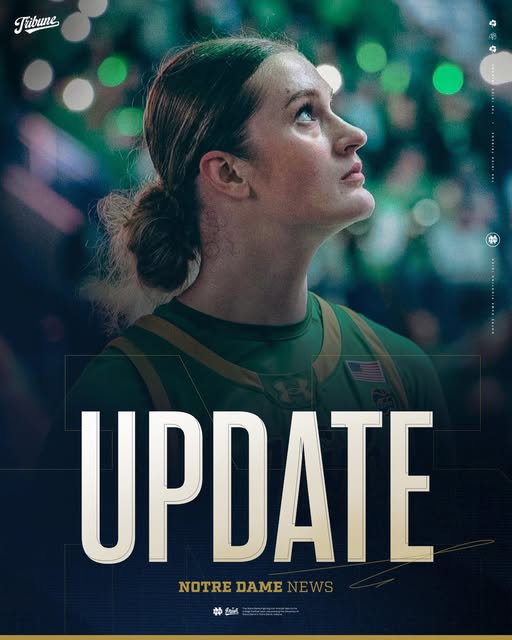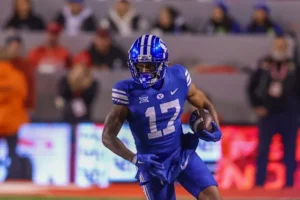
Former 5 center Kate Koval has entered the transfer portal after just one season with Notre Dame
In a year that saw a significant amount of movement within college basketball, former Notre Dame center Kate Koval’s decision to enter the transfer portal after just one season has generated considerable attention. While her time with the Fighting Irish was brief, the circumstances surrounding her departure offer insights into the evolving landscape of college sports and the individual experiences of athletes navigating high-pressure environments.
Kate Koval entered the college basketball world as one of the most highly anticipated recruits. Her 6-foot-4 frame and her dominant presence in the paint made her an instant standout. However, after only one year with Notre Dame, Koval announced her decision to enter the transfer portal, leading many to speculate about the reasons behind her move. This article explores the factors that may have influenced her decision, evaluates her time at Notre Dame, and places her experience within the broader context of college basketball’s changing dynamics.
Background of Kate Koval: Kate Koval’s rise in basketball began well before she donned the Notre Dame Fighting Irish jersey. Hailing from the state of New York, Koval gained national attention during her high school career. As a highly ranked recruit, she was known for her strong performances in both the high school and AAU circuits. Koval was seen as a top-tier recruit, and her commitment to Notre Dame was a significant moment for the program.
The expectations placed on Koval were high from the beginning. With her size, skill, and basketball IQ, she was projected to make an immediate impact in college basketball. Her game, which featured a combination of strong rebounding, shot-blocking ability, and a developing offensive game, fit perfectly with the vision of Notre Dame head coach Niele Ivey. With Ivey taking over as head coach, the Fighting Irish had hopes that Koval would help lead the program back to national prominence.
The Decision to Transfer: The decision to transfer is never an easy one, and it’s often influenced by a variety of factors. For Kate Koval, entering the transfer portal after only one season raised questions about what may have prompted her to leave the program.
Several factors may have played a role in her decision. One of the most significant aspects in any athlete’s college career is playing time. At a school like Notre Dame, which boasts one of the premier basketball programs in the country, there is intense competition for minutes. Koval may have found herself in a crowded frontcourt, where veteran players had established roles, making it harder for her to assert herself on the court as she had in high school.
Another possibility is the overall team dynamics and style of play. Notre Dame’s system under Coach Ivey might not have been the ideal fit for Koval’s strengths. While Ivey has emphasized a more fast-paced, up-tempo offense, Koval’s skill set as a traditional center with post moves and shot-blocking ability might have been underutilized in such a system.
Moreover, Koval’s departure could reflect the challenges many young players face in adapting to the rigors of college basketball. The transition from high school to college often presents unexpected difficulties, including the physical and mental demands of playing at the highest level. This can be especially difficult for freshmen who must quickly adjust to the intensity of Power 5 conferences like the ACC.
Koval’s Time at Notre Dame: During her freshman season at Notre Dame, Kate Koval showed flashes of the potential that made her a highly rated recruit. Her 6-foot-4 frame gave her an imposing presence in the paint, both defensively and offensively. Throughout the season, Koval demonstrated her shot-blocking prowess and ability to contribute as a rebounder.
However, her playing time was limited by the presence of other talented players in the frontcourt, such as veteran post players who had more experience and were already integral parts of the team. Koval played in a limited role, and her statistics reflected the challenge of adjusting to the competition in the ACC. While she had some solid performances, her role within the team might not have been as expansive as she hoped.
Despite these challenges, Koval’s potential remained clear. In a different system or with a greater role on the team, she could have flourished. Her decision to enter the transfer portal was likely a reflection of her desire to find an environment where she could develop her game further and receive more consistent playing time.
Impact of the Transfer Portal: The transfer portal has fundamentally altered the landscape of college basketball. While transfers have always been a part of college sports, the advent of the transfer portal has made the process more accessible and transparent. The portal allows players to publicly declare their intent to transfer, which has led to a significant increase in the number of players moving between schools each year.
For players like Koval, the transfer portal offers a chance to reset and find a better fit for their talents. It provides an opportunity for athletes to seek out programs that align more closely with their playing style, developmental goals, and long-term aspirations.
However, the transfer portal also presents challenges. For athletes, there is uncertainty about the future—will they be able to find a new home, and if so, will it be a better fit than their previous program? For programs, the portal can disrupt team chemistry and force coaching staff to re-evaluate their rosters each season. As more players enter the portal, the dynamics of college basketball continue to shift, making it harder to predict team success.
Koval’s Future: As Koval enters the transfer portal, the big question is where she might land. Her size, athleticism, and skill set make her an appealing prospect for numerous programs. She could potentially fit well in a system that values a traditional center, where her ability to block shots, rebound, and contribute in the post would be fully utilized. It’s also possible that she could find a program that runs a more traditional half-court offense, where she can establish herself as a focal point of the team.
In addition, Koval may have a better chance at a program that could offer her more playing time. As a highly rated recruit, her decision to transfer is a signal that she wants to maximize her development and potential, something that may not have been fully realized during her freshman season at Notre Dame.
Her transfer decision is not necessarily a step backward but could be a strategic move in securing a brighter future. For players of Koval’s caliber, transferring can often lead to a stronger career trajectory, as they are able to find a better environment to develop their skills and play at a higher level.
The Bigger Picture: Trends in College Basketball: Koval’s decision to transfer is not an isolated case but rather a reflection of the broader trends in college basketball. Increasingly, players are leaving programs after just one or two seasons, seeking better opportunities for playing time and development. This trend is especially pronounced among top recruits, who often enter college basketball with high expectations and a desire to make an immediate impact.
For coaches, this can be both an opportunity and a challenge. On the one hand, the transfer portal allows them to bring in talented players who might be able to immediately contribute. On the other hand, the revolving door of players can make it difficult to establish consistent team chemistry and build long-term programs.
The growing number of players transferring also highlights the pressures faced by student-athletes. The transition to college basketball is demanding, and for some, it can be difficult to adapt to the increased physicality, speed, and mental strain of playing at the highest level. The transfer portal provides an avenue for athletes to find a more supportive environment, whether that be through playing time or system fit.
Conclusion: Kate Koval’s decision to leave Notre Dame after just one season is a reflection of the evolving nature of college basketball, where players are increasingly taking control of their own careers and making decisions that best suit their long-term goals. While her time at Notre Dame was short, it has likely set the stage for her next chapter. Her decision, along with the broader trend of players transferring early in their careers, signals the ways in which athletes are navigating an ever-changing landscape in college sports.
Koval’s future remains bright, and wherever she lands next, she will undoubtedly continue to develop into one of the top players in college basketball. Her journey is a reminder of the complexities and challenges of collegiate athletics and the resilience required to navigate the highs and lows of the sport.





